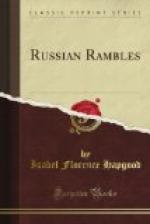cheapest of the “downy” furs, which are
the proper sort for the climate, is the brown goat,
that constantly reminds its owner of the economy practiced,
by its weight and characteristic strong smell, though
it has the merit of being very warm. Next come
the various grades of red fox fur,—those
abundantly furnished with hair,—where the
red is pale and small in area, and the gray patches
are large and dark, being the best. The
kuni,
which was the unit of currency in olden days, and was
used by royalty, is the next in value, and is costly
if dark, and with a tough, light-weight skin, which
is an essential item of consideration for the necessary
large cloaks. Sables, rich and dark, are worn,
like the
kuni, by any one who can afford them,—court
dames, cavaliers, archbishops, and merchants, or their
wives and daughters,—while the climax of
beauty and luxury is attained in the black fox fur,
soft and delicate as feathers, warm as a July day.
The silky, curly white Tibetan goat, and the thick,
straight white fur of the
psetz, make beautiful
evening wraps for women, under velvets of delicate
hues, and are used by day also, though they are attended
by the inconvenience of requiring frequent cleaning.
Cloth or velvet is the proper covering for all furs,
and the colors worn for driving are often gay or light.
A layer of wadding between the fur and the covering
adds warmth, and makes the circular mantle called
a
rotonda set properly. These sleeveless
circular cloaks are not fit for anything but driving,
however, although they are lapped across the breast
and held firmly in place by the crossed arms,—a
weary task, since they fall open at every breeze
when the wearer is on foot,—but they possess
the advantage over a cloak with sleeves that they
can be held high around the ears and head at will.
The most inveterate “shopper” would be
satisfied with the amount of running about and bargaining
which can be got out of buying a fur cloak and a cap!
The national cap has a soft velvet crown, surrounded
by a broad band of sable or otter, is always in fashion,
and lasts forever. People who like variety buy
each year a new cap, made of black Persian lambskin,
which resembles in shape that worn by the Kazaks,
though the shape is modified every year by the thrifty
shopkeepers.
The possibilities for self delusion, and delusion
from the other quarter, as to price and quality of
these fur articles, is simply enormous. I remember
the amusing tags fastened to every cloak in the shop
of a certain fashionable furrier in Moscow, where “asking
price” and “selling price” were
plainly indicated. By dint of inquiry I found
that “paying price” was considerably below
“selling price.” Moscow is the place,
by the way, to see the coats intended for “really
cold weather” journeys, made of bear skin and
of reindeer skin, impervious to cold, lined with downy
Siberian rat or other skins, which one does not see
in Petersburg shops.




